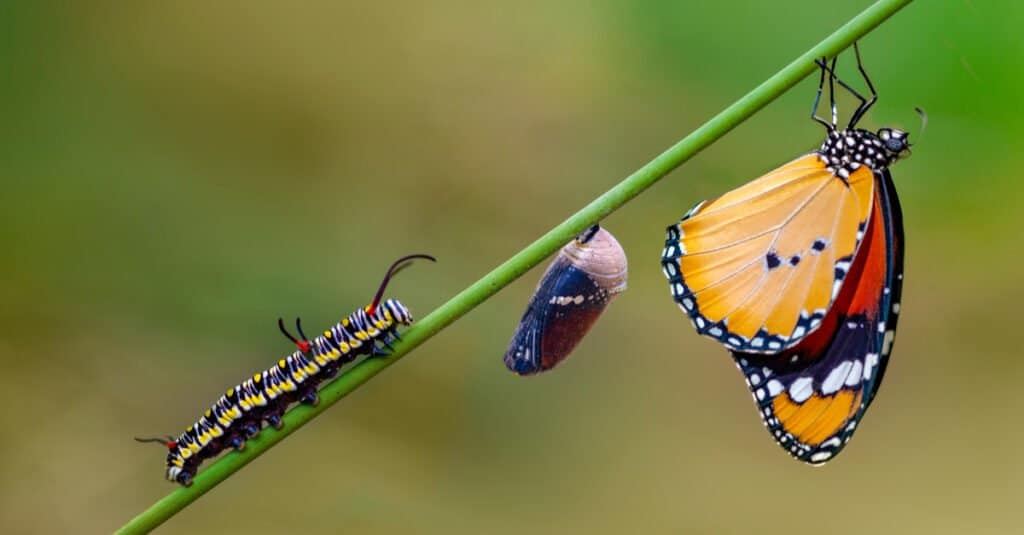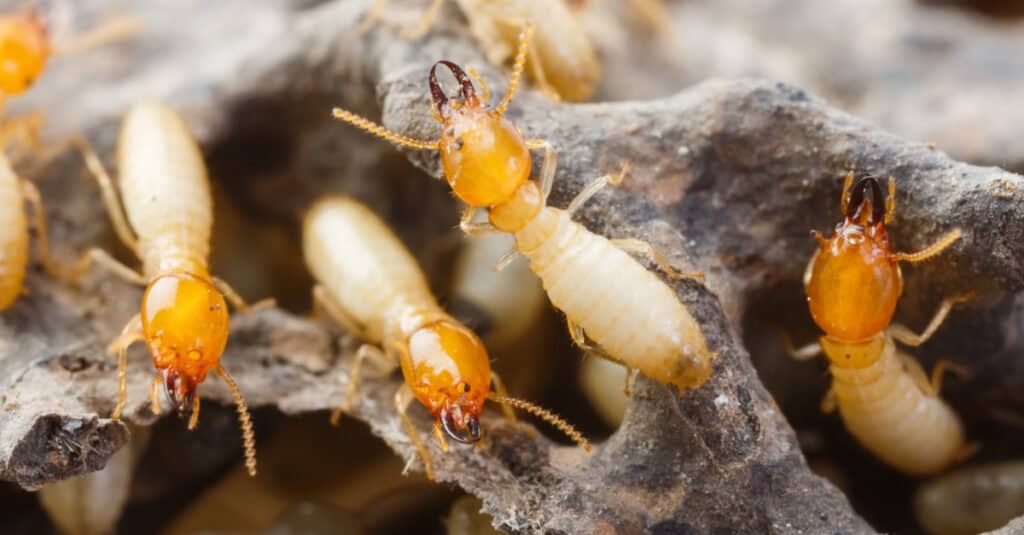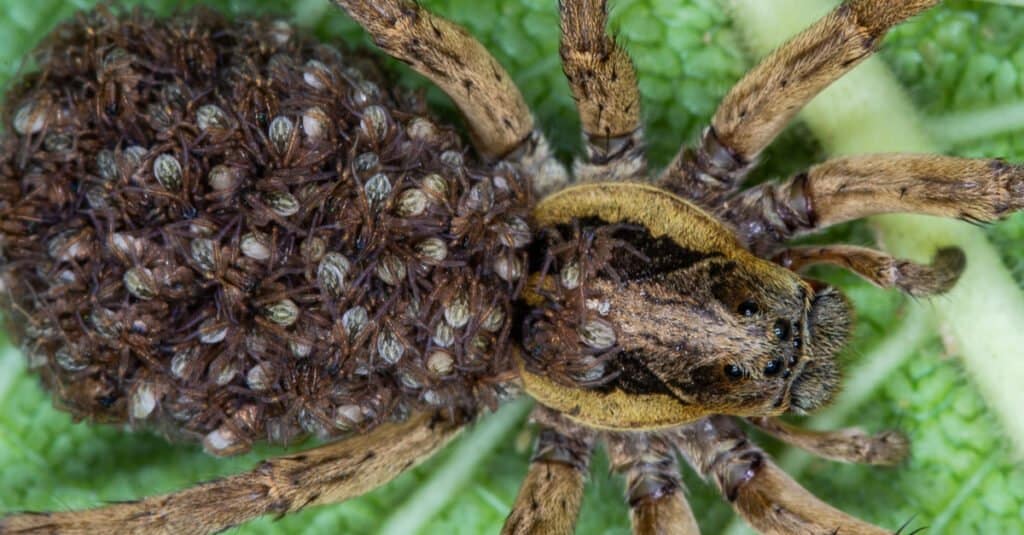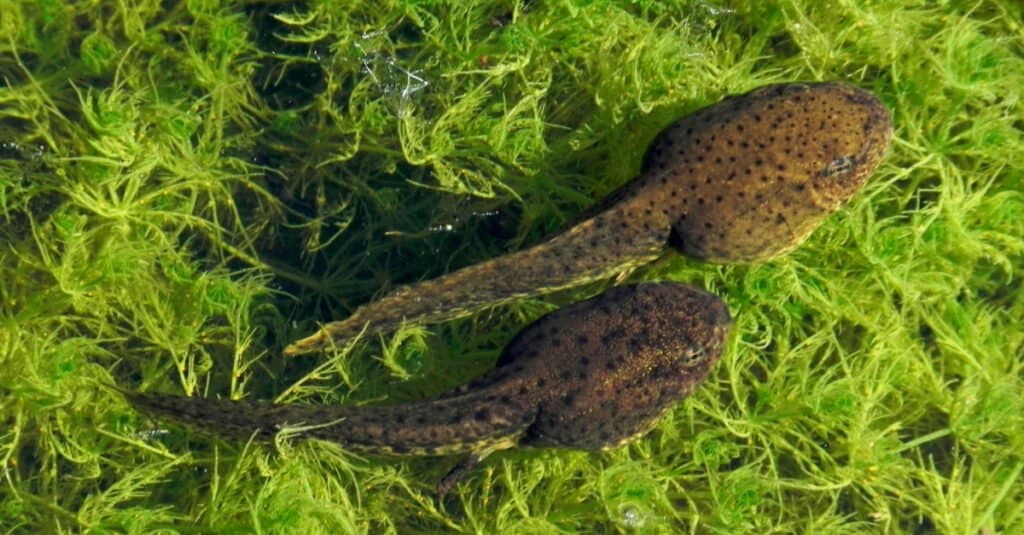Which Animal Has The Food Chain Egg Larva Pupa Adult
All animals, including humans, go through changes, including biochemical, physiological, morphological, and anatomical changes. Changes continue throughout our lives every bit cells die and replicate, and equally age morphs our bodies. But with virtually animals, changes are slight and often ephemeral. A lot of changes are hormonal, chemical shifts that touch on development and growth.
And and then there's metamorphosis.
Metamorphosis is a biological process that involves an abrupt change in an animal.
The word "metamorphosis" is Greek, and it means to change or transform in shape. It entails an young course transitioning into adulthood in singled-out stages — going from one type of life class to a completely unlike ane.
Unlike the typical subtle developments in animals, metamorphosis is dramatic. It'due south controlled by a release of hormones in the cells. Mammals usually motility from adolescence to adulthood and old historic period gradually, maintaining their form and shape. However, in metamorphosis, an animal moves through those stages and changes from i form or shape to another.
Metamorphosis occurs in animals such equally amphibians, insects, and fish. The most mutual (and popular) examples of metamorphosis are the transformation of a tadpole to a frog and a caterpillar to a butterfly. Only there are certainly other animals that go through a metamorphosis that accept equally interesting stories.

sezer66/Shutterstock.com
Butterflies are the adult stage of an insect belonging to a group called Lepidoptera, which is a Greek discussion meaning "scaly wings."
The term is apropos, every bit the wings of these insects accept thousands of overlapping tiny scales. They give the butterfly its stunning appearance every bit the scales are set in colorful patterns unique to their species.
Collywobbles have the typical body of insects: head, thorax, belly, and vi legs. They also have an exoskeleton and 2 antennae.
The first stage of butterfly life is the ovum or egg. These shells are tiny and can exist cylindrical, round, or oval. Females attach eggs to found stems or leaves, which serve equally food when the larvae hatch.
At the second stage, the larva/caterpillar hatches. The new fauna may have a number of legs. Several pairs will be true legs but some volition be faux legs (prolegs). The caterpillar has a voracious appetite and spends virtually of its life eating. It grows a lot during this phase, only the outer pare doesn't abound along with the residual of its body. Outgrowing its peel, the caterpillar molts, shedding one exoskeleton and replacing it with some other. Caterpillars may get through up to five molts.
The third stage is the chrysalis or pupa. Caterpillars find a twig and make information technology home. (They may use a wall or other support.) The exoskeleton splits and reveals the chrysalis. The chrysalis crush hangs like a sack.
Inside the shell, the caterpillar breaks down. It rearranges its construction, growing a new body, legs, and wings. Dissimilar the caterpillar, the pupa doesn't eat. It survives on energy from nutrient eaten during the larval stage. This third step tin last from several days to twelve months.
The terminal stage is the nascency of the adult butterfly. The chrysalis splits, and the butterfly emerges.
Virtually adult collywobbles live a week or two. Some species live as long as eighteen months.

seventh Son Studio/Shutterstock.com
While found all over the earth and in whatsoever environment, the majority of termites alive in rainforests.
Termites undergo what's chosen "incomplete metamorphosis." This differentiates their life bike from eusocial insects like ants, wasps, and bees. In consummate metamorphosis, the juvenile hatches and goes through a series of molts and growths with each stage until it becomes an adult. With incomplete metamorphosis, on the other manus, the changes appear more than gradually.
Termites deport a potent resemblance to the adult workers that watch over them, and the worker termite's metamorphosis comes in three stages:
- Egg
- Nymph
- Developed
The egg cycle ends after about four weeks, the nymph stage lasts at least a calendar month (though information technology depends on the climate), and adult stages run from ane to several years. The entire process can vary from species to species and alter based on the ecosystem.
The nymphs are mobile, peculiarly in avant-garde stages. They're not set up to work, merely they move about the nest freely. The nymph can get through up to seven molts but does not molt in solitude. Adult workers chew on and aid them shed their outer skin. Some species, like the damp-wood or dry-wood termite, can molt with no assistance.
Castes in the colony originate during the worker instar, and the termite population is consistent with their pheromones and food supply. For example, there are always a sure number of soldier termites. If there were a war and all of the soldier termites died, the pheromone imbalance would restore the population balance.
While termites can live a decade, their boilerplate lifespan is 1–five years.

Albie Venter/Shutterstock.com
At that place'southward an estimated 11,000 to 12,000 species of grasshopper. Big grasshoppers can bound xx times the length of their bodies. Grasshoppers can abound between ii and five inches, and the females are typically larger than the males.
Grasshoppers pass through several nymph stages. The immature grasshopper hatches in an developed form, and the external skeleton morphs during growth.
Grasshoppers, as well, get through an incomplete metamorphosis process. It takes about 2 months for the animals to get from egg to adult.
Adult females lay eggs throughout the summer and autumn, and the eggs stick together, forming a pod. Depending on the species, pods can consist of a few eggs or several hundred. Females bury the pods to proceed them condom.
The nymph stage is the side by side phase. Later on hatching, nymphs survive on soft and delicious found foliage. Nymphs closely resemble adult grasshoppers. During this step, the grasshopper will shed 5 to six times, and the molting leads into the developed phase.
This phase tin can last up to 6 weeks, at which indicate the brute is mature. The lifespan of the developed is around 1 twelvemonth. The adult female person immediately starts laying eggs, which is a process she'll continue doing throughout her lifespan, laying eggs every 3 to 4 days.

Spiders go through an incomplete metamorphosis. The three complete growth stages are:
- Egg
- Spiderling
- Adult
There's no pupal stage with arachnids — the spiderlings wait like smaller versions of the adult. With spiders, the exoskeleton doesn't grow, then the spider has to shed or molt its exoskeleton several times.
Most spiders driblet eggs into silken sacs. Some species may secure their sacs in a web, or attach them to leaves or twigs. Others deport the sac until the eggs hatch. In that location are even immature spiderlings that cannibalistically eat their own kind.
The embryonic stage is the product and storage of the egg. Some spiders in temperate ecosystems overwinter in the sac, and mothers guard the egg sacs against predators.
In a unique move, female wolf spiders comport the sac and, when information technology's time, bite it open to free their spiderlings. The immature may and then spend over a calendar week atop the mother'south back.
The spiderling stage is the immature phase. In one case hatched, they disperse right away. Some walk, others may balloon. "Ballooning" is a tactic that spiders apply to travel keen distances. They climb and perch on an object. Raising their abdomens, they spin silk threads that catch the current of air and carry them away. Studies reveal that, in some cases, they tin travel several miles.
As they grow, spiders molt repeatedly. After a shedding, they're extremely vulnerable, and they are carefully guarded by their mother.
Spiders live an average of one to 2 years. In adulthood, spiders mate and repeat the life cycle. Females tend to have longer lifespans. Males die usually after mating.
Tarantulas have unusually long lives. Females live upwardly to 2 decades, and these spiders go on molting even after full maturity. Should the female tarantula molt after mating, she has to mate again equally sperm storage and the exoskeleton eliminates the possibility of birthing new life.

Joshua Ouellette/Shutterstock.com
The evolution of the frog is one of the near famous and popular forms of metamorphosis. The early on stages of the life cycle revolve effectually eggs and tadpoles. Over the morphing period, lungs replace gills and limbs grow in as the tail disappears.
Frog eggs are released and left floating in a trunk of h2o, ordinarily a pond. The egg cluster is an "egg mass." There can be upward to 4,000 eggs in 1 laying.
Tadpoles hatch and alive in the water. Also called polliwogs, tadpoles are aquatic larvae. These creatures have oval, brusque bodies and broad tails, and there are no external gills. The operculum conceals the internal gills, which are like a modest door that opens and closes.
The tadpole gradually turns into a froglet. The transformation includes amazing things similar the growth of legs and artillery. The body develops definition and the tail loses its silken covering. Soon, the tail shrinks. The lungs develop and the back legs continue to grow until the transformation is complete. When they shed skin, frogs consume some or all of it.
Next Up: So, What Do Jellyfish Consume and How Practise They Eat Information technology?
Source: https://a-z-animals.com/blog/5-animals-that-go-through-metamorphosis-how-they-do-it/
Posted by: greenfieldbutivene.blogspot.com

0 Response to "Which Animal Has The Food Chain Egg Larva Pupa Adult"
Post a Comment